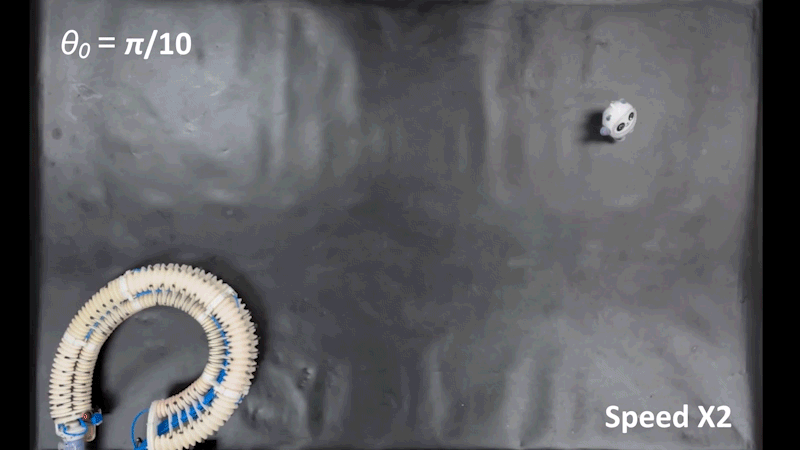A soft robotic tentacle inspired by octopuses can grasp small objects in air or water.Credit: Li Wen
Watching an octopus seize its prey has inspired researchers to develop a soft robotic tentacle, complete with suckers, that can be operated remotely with a ‘glove’ that fits over one finger1.
With their dexterity and intelligence, octopuses have long been a source of fascination and inspiration to scientists working in robotics. “They have hundreds of muscles. They can control so many muscles and so many degrees of freedom,” says Li Wen, a robotics researcher at Beihang University in Beijing, who led the research. He says such range and flexibility of movement “is totally different to traditional robots”.
The research team was particularly interested in the ‘bend propagation’ movement that the octopus uses to flick out its arm and capture passing prey. The bending motion starts at the base of the arm and travels as a wave to the tip, which then wraps around the luckless fish or other creature and attaches to it with suckers so the prey doesn’t wriggle away as it is brought to the octopus’ mouth.
“We decided to do this project because we saw how octopus capture prey in a very elegant way,” Wen says.
Octopus arms are unusual in that they operate almost independently of the octopus brain. “The animal uses very, very few control signals from the brain to the arm,” says study co-author Cecilia Laschi, a biorobotics engineer at the National University of Singapore. “The arm itself has the nervous system arranged in a way that’s a sequential activation, so the processing computing effort is very limited.”
To mimic this, the researchers had to mathematically model the bend-propagation movement.
The robotic tentacle consists of five segments made of soft silicone embedded with ‘wires’ made from metal that is liquid at room temperature. Along with standard silicon chips, these form an electronic network that mimics the nervous system in an octopus arm. The tip of the robot tentacle is equipped with suckers and temperature sensors. The whole system forms a stand-alone unit that is operated wirelessly by a one-finger glove equipped with sensors that pick up not only the fine movement of the operator’s finger but also the pitch, roll and acceleration of their hand and arm, and transmit that movement to the tentacle. Like a real octopus arm, the octobot can expand 1.5 times its original length as it reaches for its target.
A sucker for robotics
The researchers wanted to incorporate a sensory element into the design, allowing the robot’s operator to directly feel the engagement of the suckers at the tip of the tentacle.
Accordingly, the inside of the glove contains three suction cups that connect with the wearer’s finger. These translate the suckering effect of the robotic tentacle, so the operator can sense when the robotic suckers have latched on to the target.
In tests of the robotic tentacle, it was able to snatch prey — in the form of a plastic toy — and worked well in both air and water.
Robotics researcher David Howard at the Australian science agency the Commonwealth Scientific and Industrial Research Organisation in Brisbane, says achieving the “embodied intelligence” seen in octopuses is a major goal for soft robotics.
“The main thing that really resonated with me was how they’re bioinspired all the way through their design methodology,” says Howard.
He also noted the direct translation of movement from human to robot using the glove, rather than operating it through an interface such as a controller. “In robotics as a whole, one of the big unanswered questions is: what is the best way for a human to interact with a robot?” Howard says. “This is interesting because it’s like a one-to-one mapping almost, between the human and the octopus movement.”
Translating delicate movement, especially gripping, is a major challenge in soft robotics, says biomedical engineer Dietmar Hutmacher at the Queensland University of Technology in Brisbane. “You need a force, which you need to highly control to grip something but not damage it,” says Hutmacher.
Laschi says the technology could have applications in everything from marine research — capturing fast-moving items in water — to biomedical technology such as endoscopes for investigating the gastrointestinal tract, and even artificial organs.
